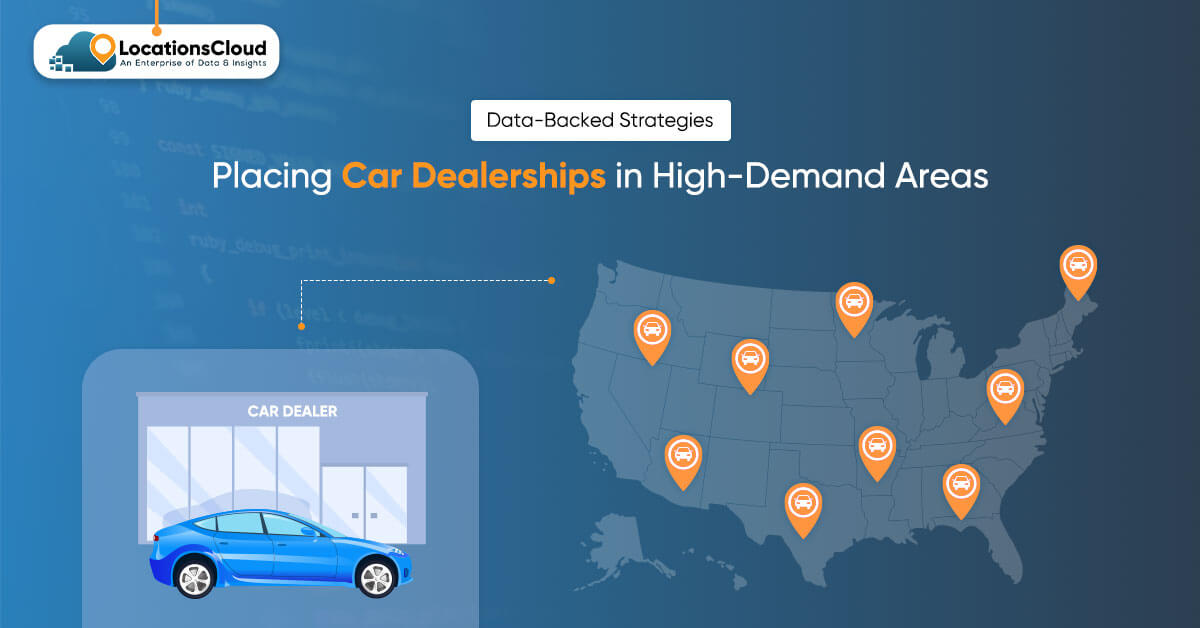
People still want to visit car showrooms, test drive them, talk with the sales representatives, learn more about features, and then make the purchase decision. They even wish to compare the cars at the showroom to know better about available options. In fact, a Cox Automotive research report for 2024 reveals that only 5% of car shoppers buy online.
It means that car dealerships are safe from the online competition and, to some extent, from the AI disruption. However, to run a successful car dealership, you have to start it at a favorable location.
Why? Car dealerships or car showrooms are the place of interaction between prospects who want to buy a car and the available car options. People buy cars from these dealerships. Having your showroom in a poor demand area can be disastrous for your business.
Therefore, you need to find the optimal location to open your car dealerships in areas where demand stays high. Location data analytics can help you place car dealerships in high-demand areas.
This research examines how data-backed strategies for placing car dealerships in high-demand areas are crucial for a profitable business.
Key Findings:
- Demographics such as income levels, age groups, etc., strongly affect location choice for car dealerships. Target high-population suburbs with rising income levels.
- Positioning near other dealerships increases foot traffic through “convenience shopping,” despite higher competition.
- Areas with rising incomes but lower vehicle ownership rates present prime opportunities for new dealerships.
- Affordable real estate prices with a high density population are ideal locations for car dealerships.
- Dealerships in high-traffic areas (2,000- 5,000+ passing vehicles daily) see significantly better performance.
- Shoppers prefer car showroom locations that fall into their regular commute routes.
- Regional car sales data help forecast dealership viability in specific locations.
- Complementing physical locations with geofencing, virtual showrooms, and AI-driven market analysis extends opportunities.
Top 10 Data-Backed Strategies for Placing Car Dealerships in High-Demand Areas
Demographics Data
Data about people’s income, age group, professions, and family type can help in forecasting demand for cars in a particular area. High population suburbs are profitable. The demographics data is one of the key datasets to assist location analysis for new car dealerships and automotive expansion. If the demographics point towards rising incomes, it indicates a favorable situation for car dealerships.
Dealership Competition
Generally, car dealerships are located near each other. This is done for convenience shopping. ICustomers naturally get attracted to a place where there are more shops of a particular product. The same applies to car dealerships. On the one hand, it increases competition; on the other, it is a natural advantage as you will see greater foot traffic. If your services, car brands that you have in the inventory, reviews, and prices are better than those of competitors, you have a greater chance of success.
Vehicle Ownership Rates
Each location has a different vehicle ownership rate. It shows how many vehicles are in a place compared to the population. So in an area where there are 30 car owners in a population of 1000. The car ownership rate is merely 3%. If there are 300 car owners in a population of 1000, the car ownership rate is 30%. There is more potential for a car dealership in an area (suburb) that has rising income but a lower vehicle ownership rate.
Real Estate Pricing and Land Availability
The cost and availability of real estate significantly impact the feasibility of opening car dealerships. Areas with moderate real estate pricing, adequate land availability for expansive parking lots, and showroom spaces are preferable. Using real estate analytics can help identify locations that provide a balance between high traffic and affordability.
Location Analytics from Repair Shops
Data about how many cars come for repair, modifications, AC fitting, Gas kit installations, sensors change, and general services provides a glimpse into the area’s potential for a new car dealership. Post-service data from other car dealerships can also help. Customers generally want to service their car locations near their homes or workplaces. The same applies to car purchase considerations. It becomes easier to visit and find variants if the car dealership is in the vicinity.
Data from Car Telematics
Companies that offer car telematics services (dashboard analytics) also provide data on how many cars pass through a particular area or how many cars are present generally in a location. A broader data access of data, like which components are failing, GPS location, and navigation data, can also help get more info on the upcoming requirements.
Traffic Pattern Analysis
Dealership visibility increases if you are situated in high-traffic areas (bypassing traffic). Minimum traffic threshold for opening a car dealership differs from area to area, but a standard number would be at least 2000-5000 vehicles passing daily. In fact, in places where daily vehicle count bypassing a car dealership exceeds 10K, it shows 38% higher traffic counts. In this analysis, commuter route positioning is important. If dealerships are situated on commuter routes, their visibility increases manifold.
Brand Alignment
Your car dealership sells cars from a particular car brand or vehicle type. If the local preference is different and they have a specific liking or inclination towards another brand, then your dealership may struggle to survive. Understanding the local market’s preferences for particular car brands or vehicle types is crucial. Data on brand-specific sales performance helps in deciding your dealership’s car brand match with local preferences.
Accessibility
Shoppers want to reach and access car showrooms easily. If they have to do a cross-traffic maneuver or if there are U-turn requirements on busy roads, or parking difficulties, shoppers may choose other dealerships. In this category, distance from their workplace, home, and other POIs may also count. Generally, car shoppers prefer to visit showrooms that are on their way to work. In this case, shoppers try to visit the dealership after work hours. Any deviation from their path may affect their decisions.
Economic Indicators at the Location
Economic indicators such as employment data, economic growth data, stability metrics, consumer sentiments, dealership expansion rates, car sales data (regional), etc. can help forecast the viability of ‘car dealership success’. Local sales data from other dealerships, car insurance companies, etc. can help you understand automotive purchasing power at select places.
Other Factors
Other key factors that car dealership aspirants must consider include Zoning laws. If a particular car type is banned in a region or if there are limits on engine horsepower or cc, then it can affect your dealership’s profit viability. Also, checking the supply chain route is essential. Car dealerships also provide post-sales service, and therefore, you require quick availability of auto parts to keep customers happy. Evaluate how fast you can get the parts from the original equipment manufacturer to the place where you are about to set up your dealership.
Maximizing Dealership Success by Combining Location Intelligence and Advanced Technology
Geofencing & Virtual Showrooms
The integration of digital technologies with physical dealership locations creates a synergy for 5X more powerful and compelling customer experiences. Geofencing technology can send targeted promotions to potential customers when they enter specific areas. The geofencing market is projected to grow to 12.23 billion industry, backed by location-based services. Virtual showrooms can complement physical spaces for an immersive experience. These technologies extend your dealership’s reach beyond physical limitations.
Seasonal Pop-up Showrooms
Car buying patterns show seasonal variations. Establishing temporary pop-up showrooms in vacation destinations, places near POIs, or near shopping centers during holiday seasons can help in capturing additional market share. Consider retail foot traffic to other prominent places like Malls, shopping centers, and holiday parks, etc., and collaborate with them to have your pop-up car showroom with selected flagship car models. These stores are great for branding.
Emerging Market Analysis with AI/ML
Use AI and machine learning algorithms to run on location datasets to identify emerging high-potential areas before they become obvious to competitors. Analyze demographics data, infrastructure development, government policies, employment data, etc. to predict future demand hotspots. It will give your dealership a first-mover advantage in developing neighborhoods.
Sustainability Considerations in Location Selection (EV Tech)
Opening a car dealership with fuel variants only in a place where environmental factors are taken seriously by car owners can be detrimental. Dealerships positioned in eco-conscious communities must focus on EV models. This also means that if you are a car dealer with EV models only, you cannot open it at a place where environmental factors or sustainability are not given any importance in car purchasing decisions. Location analysis should include green zoning benefits and proximity to renewable energy sources.
Contact Us for Data-Driven Dealership Solutions!
Ready to find the perfect high-demand location for your next dealership?
Our experts use cutting-edge data analytics to guide your expansion strategy. Get in touch today for a free consultation!
How to get Advanced Location Intelligence for Car Dealerships?
Dealerships can use advanced location intelligence tools, GIS systems, web scraping, and ready-made Car Dealerships location datasets to get the required analytics for opening car dealerships at perfect locations.
Location datasets such as car dealership location datasets from top 10 dealerships in the USA or top 10 car dealerships of California, etc., can help gauge the competition.
These datasets tell a lot about hotspots for car dealership investment. The location datasets include the car dealership location information, state-wise, zone-wise, ZIP code-wise, and their addresses and coordinates. Companies like LocationsCloud provide location datasets for car dealerships.
Another method to get location intelligence for car dealerships includes web scraping the locations of top car dealerships from their store locators, Google Maps data, and directories. Advanced web scrapers are deployed for this.
Conclusion
Car dealerships still play a key role in car sales, as purchasing online hasn’t picked up yet. This means picking the right spot for a dealership has a significant impact on how well the business does in the long run. This research sheds light on data-driven ways to find areas with high demand that are perfect for car dealerships.
Data is key to all endeavors car dealerships make to secure optimal locations for opening their showrooms. Location datasets are critical for decision-making for your next spot to establish car dealerships.
LocationsCloud has expertise in extracting, tabulating, and providing ready-made datasets about car dealerships across the USA and all other major countries.
Get premium quality datasets about top car dealerships from LocationsCloud Now!


